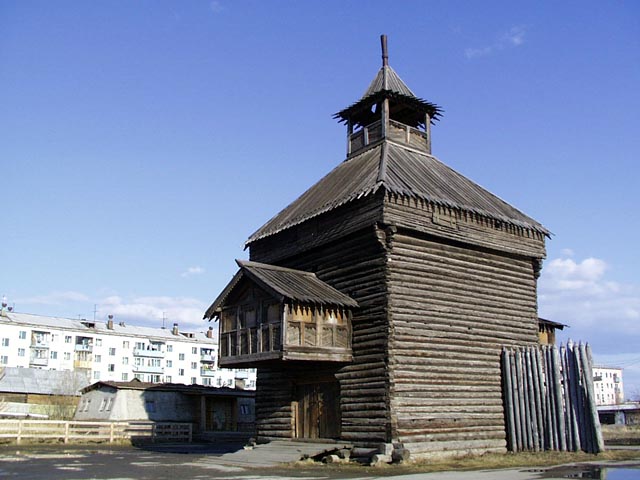Ostrog (fortress) on:
[Wikipedia]
[Google]
[Amazon]
 Ostrog ( rus, острог, p=ɐˈstrok) is a Russian term for a small
Ostrog ( rus, острог, p=ɐˈstrok) is a Russian term for a small
 From the 17th century, after the start of the
From the 17th century, after the start of the
Ostrog
at the
 Ostrog ( rus, острог, p=ɐˈstrok) is a Russian term for a small
Ostrog ( rus, острог, p=ɐˈstrok) is a Russian term for a small fort
A fortification is a military construction or building designed for the defense of territories in warfare, and is also used to establish rule in a region during peacetime. The term is derived from Latin ''fortis'' ("strong") and ''facere'' ...
, typically wooden and often non-permanently staffed. Ostrogs were encircled by 4–6 metres high palisade
A palisade, sometimes called a stakewall or a paling, is typically a fence or defensive wall made from iron or wooden stakes, or tree trunks, and used as a defensive structure or enclosure. Palisades can form a stockade.
Etymology
''Palisade ...
walls made from sharpened trunks. The name derives from the Russian word строгать (strogat'), "to shave the wood". Ostrogs were smaller and exclusively military forts, compared to larger kremlin
The Kremlin ( rus, Московский Кремль, r=Moskovskiy Kreml', p=ˈmɐˈskofskʲɪj krʲemlʲ, t=Moscow Kremlin) is a fortified complex in the center of Moscow founded by the Rurik dynasty. It is the best known of the kremlins (Ru ...
s that were the cores of Russian cities. Ostrogs were often built in remote areas or within the fortification lines, such as the Great Abatis Line.
History
 From the 17th century, after the start of the
From the 17th century, after the start of the Russian conquest of Siberia
The Russian conquest of Siberia took place in the 16th, 17th, and 18th centuries, when the Khanate of Sibir became a loose political structure of vassalages that were being undermined by the activities of Russian explorers. Although outnumber ...
, the word ''ostrog'' was used to designate the forts founded in Siberia
Siberia ( ; rus, Сибирь, r=Sibir', p=sʲɪˈbʲirʲ, a=Ru-Сибирь.ogg) is an extensive geographical region, constituting all of North Asia, from the Ural Mountains in the west to the Pacific Ocean in the east. It has been a part ...
by Russian explorers
The history of exploration by citizens or subjects of the Russian Federation, the Soviet Union, the Russian Empire, the Tsardom of Russia and other Russian predecessor states forms a significant part of the history of Russia as well as the his ...
. Many of these forts later transformed into large Siberian cities.
When later Siberia became a favourite destination for criminals sent there to serve katorga
Katorga ( rus, ка́торга, p=ˈkatərɡə; from medieval and modern Greek: ''katergon, κάτεργον'', " galley") was a system of penal labor in the Russian Empire and the Soviet Union (see Katorga labor in the Soviet Union). Pris ...
, Siberian ostrogs became associated with imprisonment
Imprisonment is the restraint of a person's liberty, for any cause whatsoever, whether by authority of the government, or by a person acting without such authority. In the latter case it is " false imprisonment". Imprisonment does not necessar ...
, and in the 18th and 19th centuries the word ''ostrog'' often meant ''prison''.
See also
*Kremlin (fortification)
A kremlin ( rus, кремль, r=kreml', p=ˈkrʲemlʲ, a=LL-Q7737 (rus)-Cinemantique-кремль.wav) is a major fortified central complex found in historic Russian cities. This word is often used to refer to the most famous one, the Moscow Kre ...
*Blockhouse
A blockhouse is a small fortification, usually consisting of one or more rooms with loopholes, allowing its defenders to fire in various directions. It is usually an isolated fort in the form of a single building, serving as a defensive stro ...
References
Ostrog
at the
Great Soviet Encyclopedia
The ''Great Soviet Encyclopedia'' (GSE; ) is one of the largest Russian-language encyclopedias, published in the Soviet Union from 1926 to 1990. After 2002, the encyclopedia's data was partially included into the later ''Bolshaya rossiyskaya e ...
{{Fortifications
Fortifications by type
Castles by type